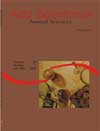<b>Influence of nitrogen and phosphorus fertilization on the yield and regrowth characteristic of Marandu grass (Brachiaria brizantha c Stapf cv. Marandu)</b> - DOI: 10.4025/actascianimsci.v26i3.1836
Abstract
The objective of this work was to evaluate the effect of nitrogen and phosphorus fertilization on the regrowth, tiller density, tiller weight, dry matter yield (DMY) and green leaf blade dry matter (LBDM), under levels of nitrogen (0; 200; 400; 600kg/ha of N) and phosphorus (0; 50; 100; 150; 200Kg/ha of P2O5) of Marandu grass (Brachiaria brizantha (Hochst) Stapf cv. Marandu), during the summer (SP) and winter periods (WP). The experimental design was randomized blocks using factorial design 4 x 5, with three replications. Nitrogen fertilization produced (p < 0.05) a linear increase in the SP and a quadratic response in the WP. The DMY and leaves dry matter yield (LBDM) had a quadratic response and a linear increase in the WP, by crescent levels of nitrogen fertilization (p < 0.05). However, tiller density showed a linear decrease, by phosphorus (p < 0.05) at RP, and a quadratic response at WP. The weight of tiller and root was not statistically different (p > 0.05) by crescent levels of nitrogen and phosphorus fertilization in both periods. Results showed that nitrogen fertilization in pasture of Marandu grass increase DMY and LBDM, during the SP, and phosphorus fertilization did not affect the analyzed variables.Downloads
Download data is not yet available.
Published
2008-04-08
How to Cite
Cecato, U., Pereira, L. A. F., Galbeiro, S., Santos, G. T. dos, Damasceno, J. C., & Machado, A. O. (2008). <b>Influence of nitrogen and phosphorus fertilization on the yield and regrowth characteristic of Marandu grass (Brachiaria brizantha c Stapf cv. Marandu)</b> - DOI: 10.4025/actascianimsci.v26i3.1836. Acta Scientiarum. Animal Sciences, 26(3), 409-416. https://doi.org/10.4025/actascianimsci.v26i3.1836
Issue
Section
Animal Science
DECLARATION OF ORIGINALITY AND COPYRIGHTS
- I Declare that current article is original and has not been submitted for publication, in part or in whole, to any other national or international journal.
The copyrights belong exclusively to the authors. Published content is licensed under Creative Commons Attribution 4.0 (CC BY 4.0) guidelines, which allows sharing (copy and distribution of the material in any medium or format) and adaptation (remix, transform, and build upon the material) for any purpose, even commercially, under the terms of attribution.
Read this link for further information on how to use CC BY 4.0 properly.
0.9
2019CiteScore
29th percentile
Powered by 








































